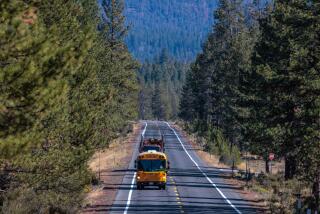Santa Clarita / Antelope Valley : Student Busing Fee Weighed : Transportation: The Castaic district is studying ways to get rid of a $250,000 deficit. About 1,200 at three campuses would be affected.
- Share via
CASTAIC — Struggling with a recurring transportation deficit of more than $250,000 a year, the Castaic Union School District may soon join three other Santa Clarita Valley school districts in imposing annual fees for busing students to and from classes.
To balance the budget, trustees are considering charging about 1,200 students who now take the bus to Castaic and Live Oak elementary schools and Castaic Middle School $200 a year. Some critics worry that such a move would force many children to walk through heavy truck traffic each day.
California reimburses schools for bus service based upon a formula established 15 years ago, with minor adjustments made for inflation but none for schools experiencing fast-growing enrollment such as those in the Santa Clarita Valley.
Enrollment is about 1,690 students in the Castaic district--more than five times what it was in 1978, Supt. Scott Brown said.
“We’re still getting paid to operate the program as if we had 300 kids,” he said.
The busing program cost the district $277,278 more than it received from the state last year--enough to hire eight more teachers or double the district’s reserve fund, officials said.
Providing bus service is expected to cost the district $263,175 more than it receives from the state this year. The district will pay the difference out of its $5.19-million general fund, Brown said.
“Could that money (otherwise) have been spent on new teachers? You betcha. Could that money have been spent on new books? You got it,” Brown said.
Three other school systems in the valley have already adopted busing fees.
Last year, the William S. Hart Union High School District and the Newhall School District began charging students $200 a year to ride the bus. In August, the Sulphur Springs School District authorized a fee of $60 per semester or $100 a year.
Castaic trustees are considering three options to defray busing costs and are looking for more.
A $100 busing fee per semester, or $200 a year, has been proposed. This would generate $63,200 per year--assuming that 70% of those who ride the bus continue to do so.
Castaic officials estimate that 30% of students who now ride the buses will find alternative transportation if the fee is enacted.
Ridership dipped about 20% for the Newhall district, which served 1,000 to 1,100 students before the fee was established.
Also suggested has been stricter enforcement of criteria for students eligible to ride the bus. Junior high students who live within 1 1/2 miles of campus and elementary schoolchildren who live within a mile of campus would be forced to walk or find other ways to get to school. The proposal would take one of the district’s 11 buses out of service, saving $27,000 in salary and $1,000 in fuel costs.
Parents and school officials are hesitant to make more students walk, however, because many would have to cross the Golden State Freeway and navigate heavy truck traffic to get to school.
A third option is for the district to contract for bus service. While informal bids indicate that the move could save $40,000 a year, Brown called that option “controversial and fraught with problems” because of the layoffs that would be triggered and concerns about maintaining the existing quality of service.
Trustees this week directed Brown to ask parents if they are willing to pay busing fees and to collect additional comments from them. He said a written survey will be distributed by the end of the month.
Some parents have suggested running a shuttle to bring students through hazardous traffic or busing only elementary schoolchildren.
Under state law, disabled students are exempted from busing fees imposed by school districts. Provisions would probably be made for low-income students, officials said.
More to Read
Sign up for Essential California
The most important California stories and recommendations in your inbox every morning.
You may occasionally receive promotional content from the Los Angeles Times.













